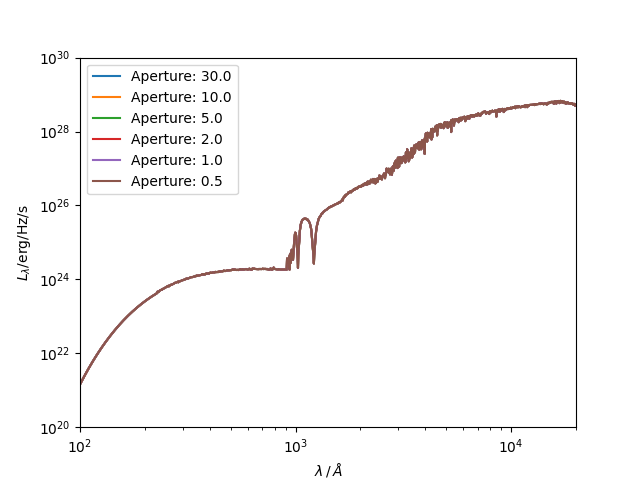Note
Go to the end to download the full example code.
Aperture Mask Example¶
Show how to implement fixed spherical apertures when getting the emission from galaxy objects.

/opt/hostedtoolcache/Python/3.10.19/x64/lib/python3.10/site-packages/unyt/array.py:1972: RuntimeWarning: invalid value encountered in divide
out_arr = func(
Galaxy centre from file: gal.centre [ 0.8626617 15.728441 7.9780293] Mpc
Stars centre adopted from parent galaxy: gal.stars.centre [ 0.8626617 15.728441 7.9780293] Mpc
Stars centre of mass: gal.stars.centre = [ 0.8626617 15.728441 7.9780293] Mpc
Galaxy centre unchanged: gal.centre = [ 0.8626617 15.728441 7.9780293] Mpc
import matplotlib.pyplot as plt
import numpy as np
from unyt import kpc
from synthesizer import TEST_DATA_DIR
from synthesizer.emission_models import IncidentEmission
from synthesizer.grid import Grid
from synthesizer.load_data.load_camels import load_CAMELS_IllustrisTNG
grid_name = "test_grid"
grid = Grid(grid_name)
gals = load_CAMELS_IllustrisTNG(
TEST_DATA_DIR,
snap_name="camels_snap.hdf5",
group_name="camels_subhalo.hdf5",
group_dir=TEST_DATA_DIR,
)
# Define an emission model
model = IncidentEmission(grid)
# Select a single galaxy
gal = gals[1]
# Test calculating the centre manually
print("Galaxy centre from file: gal.centre", gal.centre)
print(
"Stars centre adopted from parent galaxy: gal.stars.centre",
gal.stars.centre,
)
gal.stars.calculate_centre_of_mass()
print("Stars centre of mass: gal.stars.centre = ", gal.stars.centre)
print("Galaxy centre unchanged: gal.centre = ", gal.centre)
fig, ax = plt.subplots(1, 1)
for aperture_radius in np.array([30, 10, 5, 2, 1, 0.5]) * kpc:
spec = gal.stars.get_spectra(model, aperture=aperture_radius)
ax.loglog(spec.lam, spec.lnu, label=f"Aperture: {aperture_radius.value}")
ax.set_ylim(1e20, 1e30)
ax.set_xlim(1e2, 2e4)
ax.legend()
ax.set_xlabel("$\\lambda \\,/\\, \\AA$")
ax.set_ylabel("$L_{\\lambda} / \\mathrm{erg / Hz / s}$")
plt.show()
Total running time of the script: (0 minutes 0.542 seconds)